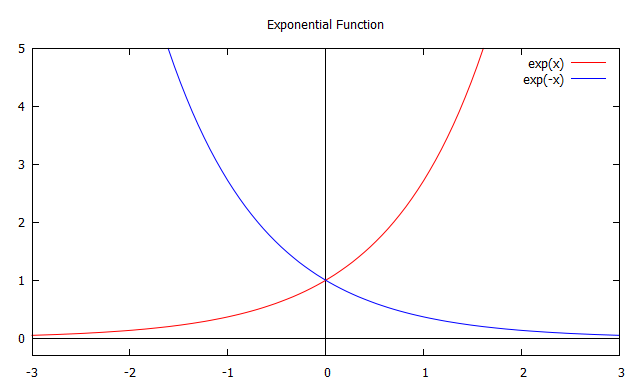Exponential and Logarithm Functions
Exponential Function
Definition
The exponential function is $y= e^x$. The value $ e$ is a constant ($\approx 2.71828\dots$). We say a function is growing exponentially or has exponential growth when the rate at which it increases is proportional to its value: $\dfrac{\mathrm{d}y}{\mathrm{d}x} \propto y$.
The negative exponential function is $y= e^{-x}$. As the the value for $x$ becomes larger, $ e^{-x}$ approaches zero. We have exponential decay when $\dfrac{\mathrm{d}y}{\mathrm{d}x} \propto -y$.
The derivative of $ e^x$ is $ e^x$ and that of $ e^{-x}$ is $- e^{-x}$.
Note: $ e^x \gt 0$ for all real numbers $x$.
Graph
Here is the graph of $ e^x$. We get the graph of $ e^{-x}$ by reflecting it along the $y$ axis.

Logarithm Function
Definition
The logarithm function is $y=\log_ax$. A logarithm to the base $10$ is commonly written as $\log$. The natural logarithm function is $y=\log_{ e}x$, more commonly denoted $\ln x$. Consider the function $y=C^x$, where $C$ is a constant. Given a value for $y$, we can find the corresponding value of $x$. A function which does this is called the logarithm with base $C$.
The derivative of $\ln x$ is $\dfrac{1}{x}$.
Note: The logarithm function is only defined for $x\gt 0$, as we cannot find the logarithm of zero or a negative number. This is beacuse $\log_bx =a \Rightarrow b^a = x $. If we try to take the log of a negative number, we get $\log_b(-x) =a \Rightarrow b^a = -x$, and there is no value for $a$ that will make this true for $b\gt 0$.
Graph
Here is the graph of $\log x$.

Workbooks
These workbooks produced by HELM are good revision aids, containing key points for revision and many worked examples.
Test Yourself
See Also
External Resources
- Exponential and Logarithm Functions workbook at mathcentre.
- Exponential and Logarithmic Functions videos at Khan Academy.